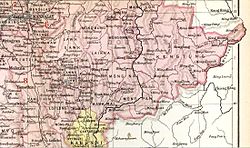Möng Nawng was a Shan state in what is today Burma.
| Möng Nawng | |||||||||
|---|---|---|---|---|---|---|---|---|---|
| State of the Shan States | |||||||||
| 1851–1959 | |||||||||
 Möng Nawng in an Imperial Gazetteer of India map | |||||||||
| Area | |||||||||
• 1901 | 4,079 km2 (1,575 sq mi) | ||||||||
| Population | |||||||||
• 1901 | 39,102 | ||||||||
| History | |||||||||
• Independence from Hsenwi State | 1851 | ||||||||
• Abdication of the last Myoza | 1959 | ||||||||
| |||||||||
Möng Nawng was bound by Kengtung State in the east. The Nam Pang, an important river, crossed the state from north to south. Its capital was Mong Nawng.[1]
History
editMöng Nawng became independent from Hsenwi in 1851 under the rulership of the myoza Heng Awn. It was a tributary of the Burmese Kingdom until 1887, when the Shan states submitted to British rule after the fall of the Konbaung dynasty.[2]
Rulers
editThe rulers of Möng Nawng bore the title of Myoza.[3]
Myozas
edit- 1851 - 1866 Heng Awn (d. 1866)
- 1866 - 1868 Hkun Hkang (d. 1868)
- 1868 - 9 Aug 1906 Hkun Tun (b. 1858 - d. 1906)
- 9 Aug 1906 - 19.. Hkun Long (b. 1851 - d. 19..)
References
edit- ^ "WHKMLA : History of the Shan States". 18 May 2010. Retrieved 21 December 2010.
- ^ Imperial Gazetteer of India, v. 17, p. 408.
- ^ Ben Cahoon (2000). "World Statesmen.org: Shan and Karenni States of Burma". Retrieved 7 July 2014.
21°30′N 98°20′E / 21.500°N 98.333°E